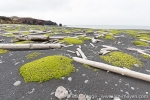
Sjuhollendarbukta
One of several bays on the southern north coast (sounds weird, but that’s how it is). „Bay“ may be a bit far-fetched, there is a wide beach, but at any wind or sea from the west or north, it will be completely exposed.

According to the Austrian expedition from 1882-83 (First International Polar Year), who had plenty of time to consider the matter on location, this is the site of the first wintering ever on Jan Mayen. All 7 winterers died, however, from scurvy. Accordingly, the Austrians called the place „7 Holländer Bucht“ or Seven Dutchmen Bay, now in Norwegian Sjuhollendarbukta.They also found some human remains and built a cross with a memorial plate. This has all gone, however, nothing can still be seen, neither any graves or human remains nor any signs of a 17th century whaling station or the wooden cross. Today it is generally believed that the wintering of 1633-34 took places further north in Kvalrossbukta.
Detail:
Sjuhollendarbukta
Next to large amounts of driftwood and typical beach vegetation, there are two huts as the only signs of human activitiy visible today. These huts do not have a background in distant history, but of course there is a story about their origin. Locally, they are know as Camp Vera or simply Vera, or to be more precise as Gamle Vera and Nye Vera (old and new Vera). Gamle Vera is said to have been built somewhere else on Jan Mayen in 1964 in connection to seismic work, it was then called „Olsen hytta“. After being damaged, it was transported to the station in 1968 for repair.
In September the same year, it was moved over land to Kvalrossbukta and then with a float to Sjuhollendarbukta. One of the initiative takers is said to have been Ove Grassbakken, a meteorological assistant, and since then, the hut is known as Vera after Ove’s wife. In 1979, Vera (the hut) was moved a bit away from the beach as it was threatened to be damaged by the surf. The driftwood shows how far inland the sea can reach under heavy storms. At the now location, the hut was, however, damaged by an avalanche or rockfall in the 1990s. In 1999 it was repaired, but it did not live up to the modern-day free time expectations of the station members, so Nye Vera was built in the vicinity in 2004. Nye Vera is, of course, larger and more comfortable, but it can certainly not keep up with Gamle Vera in terms of historical charme.
Photo gallery Sjuhollendarbukta
Click on thumbnail to open an enlarged version of the specific photo.copyright: Rolf Stange












